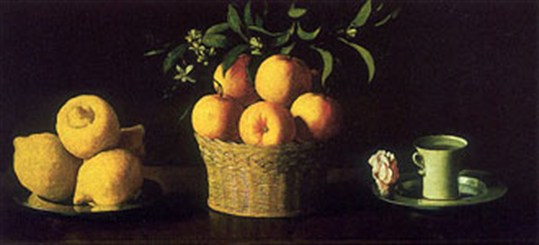Francisco de Zurbarán and the Italian still life
 Francisco de Zurbarán (1598-1664) belongs to the generation of the great masters who worked for King Philip IV, the lucky patron of the golden age of Spanish painting. Although there is no evidence that Zurbarán ever stayed in Italy, his style reveals a deep understanding of the work of Caravaggio and Italian culture. The lesson of reality of Caravaggio’s painting, with its truth of lights and shadows, is captured by the painter (who was sometimes called “the Spanish Caravaggio”) and is united with a Classical vein which is a prelude to full Baroque, with its dynamism and the triumphant optimism of forms. Shy and reserved, Zurbarán was formed in Seville with Pedro Díaz de Villanueva and dedicated the best of his production to Spanish convents. Fervent and effective in his simplicity which is devoid of artifice and amazing in its ability to reproduce the real in a direct manner (see the lavish and “superbly tangible” Crucified Christ of Chicago, 1627), Zurbarán was one of the greatest painters of still lifes of all times. The few compositions that he made exhibit the prodigious skill with which he was able to describe objects and fine details. While the native of Toledo, Juan Sánchez Cotán, the founder of the Spanish still life and an extraordinary artist in his own right, had no inkling of Caravaggio (see Still Life, 1602, Madrid, Museo del Prado), Zurbarán seems to have a direct knowledge of his work. Caravaggio powerfully influenced his style: the Spaniard must have absorbed it through the work of Ribera and Velázquez who studied in Italy, and perhaps thanks to the paintings by Italian artists in Spain (like the paintings of Carlo Saraceni in the Cathedral of Toledo). The extraordinary Still life with Lemons, Oranges and a Rose of Pasadena (1633, Norton Simon Museum, image), “in the crystalline precision of detail” (Longhi) reveals the profound admiration which Spanish felt for the Lombard artist, so that it was equated with Basket of Fruit by Caravaggio in the Pinacoteca Ambrosiana of Milan. The use of light and the glossy, almost ruthlessly detailed description is the same. Zurbarán’s solemnity of composition and the “silent poetry of objects” (Tommaso Montanari, 2012) anticipates the new and leads directly to the experience of Giorgio Morandi. By objects that seem to have “a prodigious and subtle myterious intensity” (Pérez Sánchez, 1995), the Spaniard attains “almost musical harmonies” (Longhi). He achieves this cleverly and like Caravaggio, ennobling daily experience, illuminating it with a magical light that renders the vulgar sublime.
Francisco de Zurbarán (1598-1664) belongs to the generation of the great masters who worked for King Philip IV, the lucky patron of the golden age of Spanish painting. Although there is no evidence that Zurbarán ever stayed in Italy, his style reveals a deep understanding of the work of Caravaggio and Italian culture. The lesson of reality of Caravaggio’s painting, with its truth of lights and shadows, is captured by the painter (who was sometimes called “the Spanish Caravaggio”) and is united with a Classical vein which is a prelude to full Baroque, with its dynamism and the triumphant optimism of forms. Shy and reserved, Zurbarán was formed in Seville with Pedro Díaz de Villanueva and dedicated the best of his production to Spanish convents. Fervent and effective in his simplicity which is devoid of artifice and amazing in its ability to reproduce the real in a direct manner (see the lavish and “superbly tangible” Crucified Christ of Chicago, 1627), Zurbarán was one of the greatest painters of still lifes of all times. The few compositions that he made exhibit the prodigious skill with which he was able to describe objects and fine details. While the native of Toledo, Juan Sánchez Cotán, the founder of the Spanish still life and an extraordinary artist in his own right, had no inkling of Caravaggio (see Still Life, 1602, Madrid, Museo del Prado), Zurbarán seems to have a direct knowledge of his work. Caravaggio powerfully influenced his style: the Spaniard must have absorbed it through the work of Ribera and Velázquez who studied in Italy, and perhaps thanks to the paintings by Italian artists in Spain (like the paintings of Carlo Saraceni in the Cathedral of Toledo). The extraordinary Still life with Lemons, Oranges and a Rose of Pasadena (1633, Norton Simon Museum, image), “in the crystalline precision of detail” (Longhi) reveals the profound admiration which Spanish felt for the Lombard artist, so that it was equated with Basket of Fruit by Caravaggio in the Pinacoteca Ambrosiana of Milan. The use of light and the glossy, almost ruthlessly detailed description is the same. Zurbarán’s solemnity of composition and the “silent poetry of objects” (Tommaso Montanari, 2012) anticipates the new and leads directly to the experience of Giorgio Morandi. By objects that seem to have “a prodigious and subtle myterious intensity” (Pérez Sánchez, 1995), the Spaniard attains “almost musical harmonies” (Longhi). He achieves this cleverly and like Caravaggio, ennobling daily experience, illuminating it with a magical light that renders the vulgar sublime.
